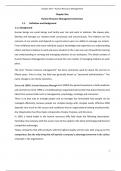Chapter One Human Resource Management
Chapter One
Human Resource Management Overview
1.1. Definition and Background
1.1.1 Background
Human beings are social beings and hardly ever live and work in isolation. We always plan,
develop and manage our relations both consciously and unconsciously. The relations are the
outcome of our actions and depend to a great extent upon our ability to manage our actions.
From childhood each and every individual acquire knowledge and experience on understanding
others and how to behave in each and every situation in life. Later we carry forward this learning
and understanding in carrying and managing relations at our workplace. The whole context of
Human Resource Management revolves around this core matter of managing relations at work
place.
The term "human resource management" has been commonly used for about the last ten to
fifteen years. Prior to that, the field was generally known as "personnel administration." The
name change is not merely cosmetics.
ement (HRM) has gained acceptance in both academic
and commercial circle. HRM is a multidisciplinary organizational function that draws theories and
ideas from various fields such as management, psychology, sociology and economics.
There is no best way to manage people and no manager has formulated how people can be
managed effectively, because people are complex beings with complex needs. Effective HRM
depends very much on the causes and conditions that an organizational setting would provide.
Any Organization has three basic components, People, Purpose, and Structure.
In 1994, a noted leader in the human resources (HR) field made the following observation:
Yesterday, the company with the access most to the capital or the latest technology had the best
competitive advantage;
Today, companies that offer products with the highest quality are the ones with a leg up on the
of people in the organization.
1
, Chapter One Human Resource Management
That predicted - and private sector firms of all
be a source
of competitive advantage.
However, in order to remain competitive, to grow, and diversify an organization must ensure that
its employees are qualified, placed in appropriate positions, properly trained, managed
effectively, and committed to the
contributions in order to achieve optimal productivity and effectiveness, while simultaneously
attaining individual objectives (such as having a challenging job and obtaining recognition), and
societal objectives (such as legal compliance and demonstrating social responsibility).
1.1.2 Definitions of HRM
Human resources management (HRM) is a management function concerned with hiring,
motivating and maintaining people in an organization. It focuses on people in organizations.
HRM is designing management systems to ensure that human talent is used effectively and
efficiently to accomplish organizational goals.
HRM is the personnel function which is concerned with procurement, development,
compensation, integration and maintenance of the personnel of an organization for the
Therefore, personnel management is the planning, organizing, directing, and controlling of
the performance of those operative functions (Edward B. Philippo).
is concerned with the most effective use of people to achieve organizational and
individual goals. It is the way of managing people at work, so that they give their best to the
Invancevich and Glueck,
HRM is
aspects of a management position, including recruiting, screening, training, rewarding, and
appraising comprises of HRM. Dessler (2008)
Generally, HRM refers to the management of people in organizations. It comprises of the
activities, policies, and practices involved in obtaining, developing, utilizing, evaluating,
maintaining, and retaining the appropriate number and skill mix of employees to accomplish the
2




